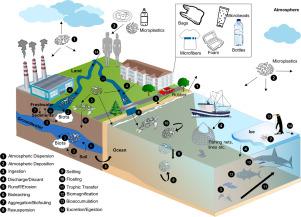Science of the Total Environment ( IF 8.2 ) Pub Date : 2020-12-04 , DOI: 10.1016/j.scitotenv.2020.143936 Fritz Petersen , Jason A. Hubbart

|
Microplastic (MP) particles have been observed in most environments and concentrations are expected to increase over the coming decades given continued and increased production of synthetic polymer products. The expected increase in plastic pollution (including MPs) may elevate the risk posed by these synthetic particles to both environmental and human health. The purpose of this review is to provide a review of the state of knowledge regarding the occurrence and transport of MPs in and across three of the Earths subsystems, specifically, the lithosphere, atmosphere, and hydrosphere. Evidence is presented that shows the lithosphere includes substantial MP accumulation (e.g. approximately 25 particles L-1 in landfill leachate), the impacts of which remain poorly understood. The atmosphere plays an important role in MP transport, with increased occurrence and higher transport concentrations noted in more densely populated areas (e.g. 175 to 313 particles m−2 d−1 in Dongguan China). In the hydrosphere, freshwater ecosystems alternate between MP transport (e.g. rivers) and deposition (e.g. lakes) with flow rate being identified as a key factor determining the movement and fate of MPs. Conversely, marine ecosystems act as a major sink for MP pollution (e.g. MP comprise 94%, approximately 1.69 trillion pieces, of plastic pieces in the Great Pacific Garbage Patch), driven by direct deposition or by transport via the atmosphere or freshwater conveyance systems (e.g. streams, rivers, or ice sheets). Once ingested by organisms, the trophic transfer and bioaccumulation of MPs has been confirmed with the polymer particles potentially accumulating in or impacting fauna, flora, microbes, and humans. Finally, 16 areas are identified in which future MP research efforts should be focused, with the goal of accurately identifying the scope and potential risks posed by synthetic polymer pollution. This review serves as a valuable steppingstone for future research and researchers wishing to address MP research gaps across various environmental settings in the coming decades.











































 京公网安备 11010802027423号
京公网安备 11010802027423号